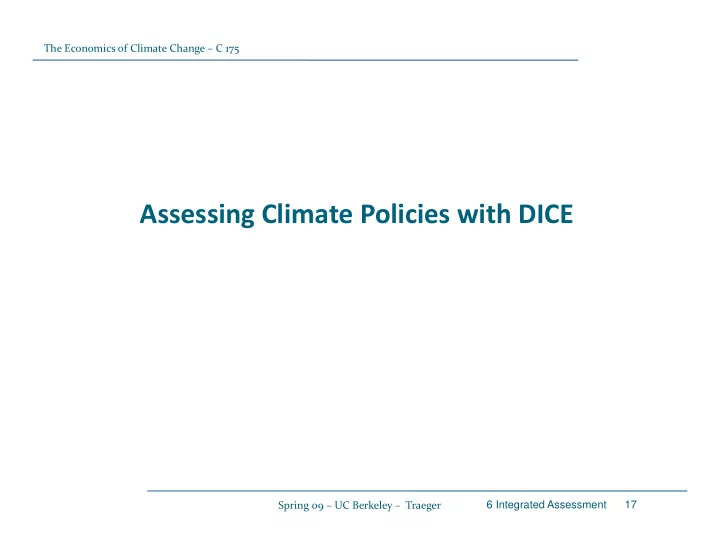

The Economics of Climate Change – C 175 Assessing Climate Policies with DICE Spring 09 – UC Berkeley – Traeger 6 Integrated Assessment 17
The Economics of Climate Change – C 175 Assessing Climate Policies with DICE The scenarios: No controls (“ baseline ”) (No emissions controls for first 250 years) 1. Optimal policy: Emissions and carbon prices set at optimal levels from 2. second period in 2010–2019. Climatic constraints with CO2 ‐ concentration constraints : 3. Si Similar to optimal case except that CO2 concentrations are constrained to il t ti l t th t CO t ti t i d t be less than a given upper limit: A. CO2 concentrations limited to 1.5preindustrial level (420 ppm) B. CO2 concentrations limited to 2preindustrial level (560 ppm) C. CO2 concentrations limited to 2.5preindustrial level (700 ppm) 4 4. Climatic constraints with temperature constraints : p Similar t o optimal case except that global temperature change is constrained to be less than a given increase from 1900. A. limited to 1.5°C B. limited to 2°C C. limited to 2.5°C D. limited to 3°C Spring 09 – UC Berkeley – Traeger 6 Integrated Assessment 18
The Economics of Climate Change – C 175 Assessing Climate Policies with DICE The scenarios continued: Kyoto Protocol . Different variants of the Kyoto Protocol. 5. A. Original Protocol with the United States. C onstant emissions at level of 2008–2012 budget (all Annex I) B. Original Kyoto Protocol without the United States. Above without the US C. Strengthened Kyoto Protocol. 6 6. Ambitious proposals Ambitious proposals A. Spirit of the Stern Review: Low discount rate. B . Gore emissions reductions: Achieve global emissions reductions of 90 percent by 2050. A hi l b l i i d ti f t b Low ‐ cost backstop technology: 7. Development of a technology or energy source that can replace all fossil fuels at current costs (which currently seems unrealistic) fossil fuels at current costs (which currently seems unrealistic). Spring 09 – UC Berkeley – Traeger 6 Integrated Assessment 19
The Economics of Climate Change – C 175 Assessing Climate Policies with DICE Source: Nordhaus (2007), Figure 5 ‐ 2, p. 86, Present value of alternative policies. Difference in the present value of a policy relative to the baseline under two measures. Diff i h l f li l i h b li d Note: Optimal means (only) optimal with respect to Nordhaus specification ! Spring 09 – UC Berkeley – Traeger 6 Integrated Assessment 20
The Economics of Climate Change – C 175 Assessing Climate Policies with DICE Source: Nordhaus (2007), Figure 5 ‐ 1. Present value of alternative policies. All scenarios. li i All i Spring 09 – UC Berkeley – Traeger 6 Integrated Assessment 21
The Economics of Climate Change – C 175 Assessing Climate Policies with DICE Spring 09 – UC Berkeley – Traeger 6 Integrated Assessment 22
The Economics of Climate Change – C 175 Assessing Climate Policies with DICE Source: Nordhaus (2007), Figure 5 ‐ 4, p.94. The (globally averaged) carbon prices under different policies. The prices are per ton of carbon, for i d diff t li i Th i t f b f prices per ton of CO2, divide by 3.67. Spring 09 – UC Berkeley – Traeger 6 Integrated Assessment 23
The Economics of Climate Change – C 175 Assessing Climate Policies with DICE Source: Nordhaus (2007), Figure 5 ‐ 5, p 98. The global for CO2 emissions ‐ control rates under different policies Note the upward tilted ramp of the strategies rates under different policies. Note the upward tilted ramp of the strategies. Spring 09 – UC Berkeley – Traeger 6 Integrated Assessment 24
The Economics of Climate Change – C 175 Assessing Climate Policies with DICE Source: Nordhaus (2007), Figure 5 ‐ 7, p.104. The atmospheric concentrations of CO2 under different policies. i f CO d diff li i Spring 09 – UC Berkeley – Traeger 6 Integrated Assessment 25
The Economics of Climate Change – C 175 Assessing Climate Policies with DICE Source: Nordhaus (2007), Figure 5 ‐ 8, p.107. Projected global mean temperature change under different policies. Increases are relative to the 1900 average relative to the 1900 average. Spring 09 – UC Berkeley – Traeger 6 Integrated Assessment 26
The Economics of Climate Change – C 175 Uncertainty To capture Uncertainty, Nordhaus runs DICE 2007 for different specifications of these of these parameters Spring 09 – UC Berkeley – Traeger 6 Integrated Assessment 27
The Economics of Climate Change – C 175 Uncertainty over social cost of carbon = optimal carbon tax Source: Nordhaus (2007), Figure 7 ‐ 3, p.135. Uncertainty bands for the social cost of carbon. i l f b Spring 09 – UC Berkeley – Traeger 6 Integrated Assessment 28
Recommend
More recommend